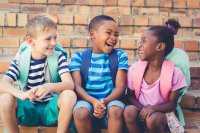Integrating SEL in the Classroom
An approach to formative assessment incorporates discussion of social and emotional learning competencies.
Your content has been saved!
Go to My Saved Content.Recently, the Aspen Institute released “The Practice Base for How We Learn: Supporting Students’ Social, Emotional, and Academic Development,” which contains several statements of practice for integrating these different aspects of learning. Among them is the recognition that “the key to fostering social and emotional development is a continuing loop in which we first help students understand why the skills are important and how they can be used effectively, then create opportunities for students to practice those skills, and finally provide feedback and time for reflection.”
One way to do this is to embed these practices in a framework known in my school network, the Athlos Academies, as the 3Rs: review, reflection, and recognition. The 3Rs function as a formative assessment tool for educators looking to better understand their students, and for students they serve to build metacognition—the ability to better think about one’s own thinking.
Implementation looks different depending on context, time constraints, and overall purpose. For example, coaches use the 3Rs during the last five minutes of physical education, and students respond to prompts as a large group using strategies like think-pair-share and concentric circles. During a core instructional block, the 3Rs may be embedded in instruction with the teacher using a Catch and Release protocol to incorporate discussion of them throughout the lesson or saving time at the end to discuss students’ learning experience in more detail.
We have found that there are a few common best practices for integrating the 3Rs:
- Use all three together, in the order they are presented. Recognition is a great way to end.
- If you use specific protocols with the 3Rs, teach and model them, and provide students with time to practice them.
- There’s no opting out: Find a way for all students to participate through scaffolding or accommodation.
The First R: Review
The review phase of learning is all about formative assessment and provides an opportunity to reconnect to the lesson’s learning targets. Questions to consider:
- What new learning has occurred?
- What do my students know now that they didn’t before?
- What can my students do now that they couldn’t before?
- What misconceptions do students have?
Review also provides an opportunity to increase students’ awareness of their own learning process. Discussing with students how they learn is as relevant as what they learned when building their metacognition.
A popular protocol we use is called Heads Together: Students are placed into groups of four by counting off and are asked to summarize their learning or respond to a prompt. The groups work together on a response and make sure that every student is prepared to represent their group, and the teacher randomly selects a number from one to four. Each student with that number presents their group’s response.
Students can also review their learning through exit tickets, brief performance tasks, or the use of online tools.
The Second R: Reflection
The reflection phase focuses on students’ acquisition and use of the social and emotional learning (SEL) competencies that support their success. The goal is to make visible for students the role SEL skills play in their learning. Questions to consider:
- How do lesson activities foster SEL skill development?
- How can I use students’ SEL skills to improve learning?
- What do I want students to understand about their own SEL skills?
SEL concepts like social awareness are abstract enough to render them meaningless to students without further unpacking. Reflecting on prompts like “How is your point of view different from your partner’s?” and “How did you use social awareness to discuss different points of view?” provides connections to the concepts for students.
Another way to help students see these connections is to create an anchor chart with three columns labeled “SEL Skills,” “Content,” and “Future Success.” Engage students in a brainstorming session to complete the following sentence frame: “When I use [SEL skill] when learning how to [content], it helps prepare me for [future success].” For example: “When I use social intelligence to solve complex math problems, it helps prepare me for working on a team like engineers do.”
Students can reflect on their learning in a variety of other ways. Group reflection protocols like the fishbowl provide structure and promote equity.
The Third R: Recognition
At this point in the process students have had the opportunity to show what they know and reflect on the learning process. The recognition phase gives them a chance to recognize each other. Questions to consider:
- Who demonstrated SEL skills today?
- How can I increase students’ awareness of SEL in action?
- How are students good models for others?
Much has been written about the overuse and downsides of generalized praise, so teach students how to use specific praise when recognizing each other. The following three-step process can help: Ask students to describe the behavior they observed, how it made them feel, and the impact it had on learning. For example: “When you included me in the process, it showed a lot of social awareness. It made me feel good that I got to share my ideas.”
Review, reflection, and recognition are not new concepts in education—their effectiveness is well known. Using them in combination with each other and with regularity increases their efficacy.
